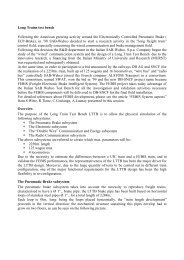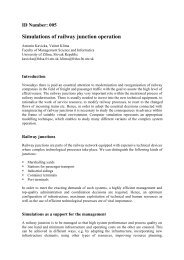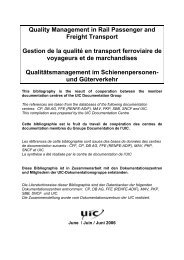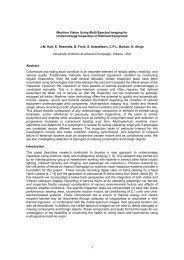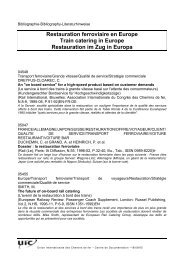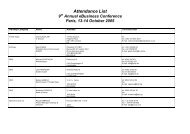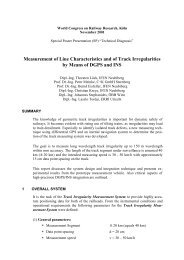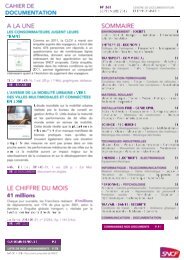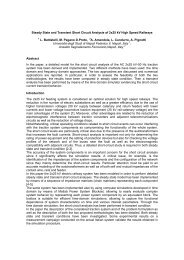Study on under-floor flow to reduce ballast flying phenomena ... - UIC
Study on under-floor flow to reduce ballast flying phenomena ... - UIC
Study on under-floor flow to reduce ballast flying phenomena ... - UIC
You also want an ePaper? Increase the reach of your titles
YUMPU automatically turns print PDFs into web optimized ePapers that Google loves.
We thought that in the downstream end the effect of the snow-accreti<strong>on</strong> reducti<strong>on</strong> was the<br />
smallest and in the area of the upper stream and center of the bogies the effect is larger.<br />
Therefore we made clear that the effect of the snow particle flux reducti<strong>on</strong> extended over large<br />
area near the bogies.<br />
SPC<br />
Deflec<strong>to</strong>r<br />
SPC<br />
Flow with snow<br />
Figure 13 Arrangement of wind tunnel tests<br />
Snow particle flux reducti<strong>on</strong><br />
(no deflec<strong>to</strong>r = 1.0)<br />
1.2<br />
1.0<br />
0.8<br />
0.6<br />
0.4<br />
0.2<br />
0<br />
Deflec<strong>to</strong>r made by equilateral<br />
triangular prisms<br />
No Def. Sd3 Sd2 Sd1<br />
Figure 14 Snow-accreti<strong>on</strong> reducti<strong>on</strong><br />
4. C<strong>on</strong>clusi<strong>on</strong><br />
We studied the <strong>under</strong>-<strong>floor</strong> <strong>flow</strong> of the car that can cause the <strong>ballast</strong> <strong>flying</strong> <strong>phenomena</strong>. Firstly,<br />
<strong>to</strong> estimate the <strong>under</strong>-<strong>floor</strong> <strong>flow</strong> <strong>under</strong> actual c<strong>on</strong>diti<strong>on</strong>s, we measured the <strong>under</strong>-<strong>floor</strong> <strong>flow</strong> in <strong>on</strong>track<br />
tests. To measure the <strong>flow</strong>, we used comb Pi<strong>to</strong>t tubes and a hot wire anemometer. The<br />
test result showed that smoothing the <strong>under</strong>-<strong>floor</strong> of the cars <strong>reduce</strong>d the <strong>under</strong>-<strong>floor</strong> <strong>flow</strong>.<br />
Sec<strong>on</strong>dly, <strong>to</strong> investigate the possibility of reducti<strong>on</strong> of the <strong>under</strong>-<strong>floor</strong> <strong>flow</strong> by modificati<strong>on</strong> of<br />
<strong>under</strong>-<strong>floor</strong> shape, we carried out wind tunnel tests by using a closed type test secti<strong>on</strong> of the<br />
Large-scale wind tunnel that has the moving-belt and the boundary layer sucti<strong>on</strong> device <strong>to</strong><br />
simulate the <strong>flow</strong> between car models and the ground. Comparing the <strong>under</strong>-<strong>floor</strong> <strong>flow</strong> in the <strong>on</strong>track<br />
tests and that in wind tunnel tests, we verified that the <strong>under</strong>-<strong>floor</strong> <strong>flow</strong> in the <strong>on</strong>-track tests<br />
was reproduced in the wind tunnel tests. We measured the velocity profiles of the <strong>under</strong>-<strong>floor</strong><br />
<strong>flow</strong> of the intermediate car by using hot wire anemometers. We <strong>under</strong>s<strong>to</strong>od that the more we<br />
smooth the <strong>under</strong>-<strong>floor</strong> shapes, the more the <strong>under</strong>-<strong>floor</strong> <strong>flow</strong> decreases. Furthermore, we<br />
developed a model running facility that enables us <strong>to</strong> estimate the velocity of the <strong>flow</strong> <strong>on</strong> the<br />
ground when the train passes by.



